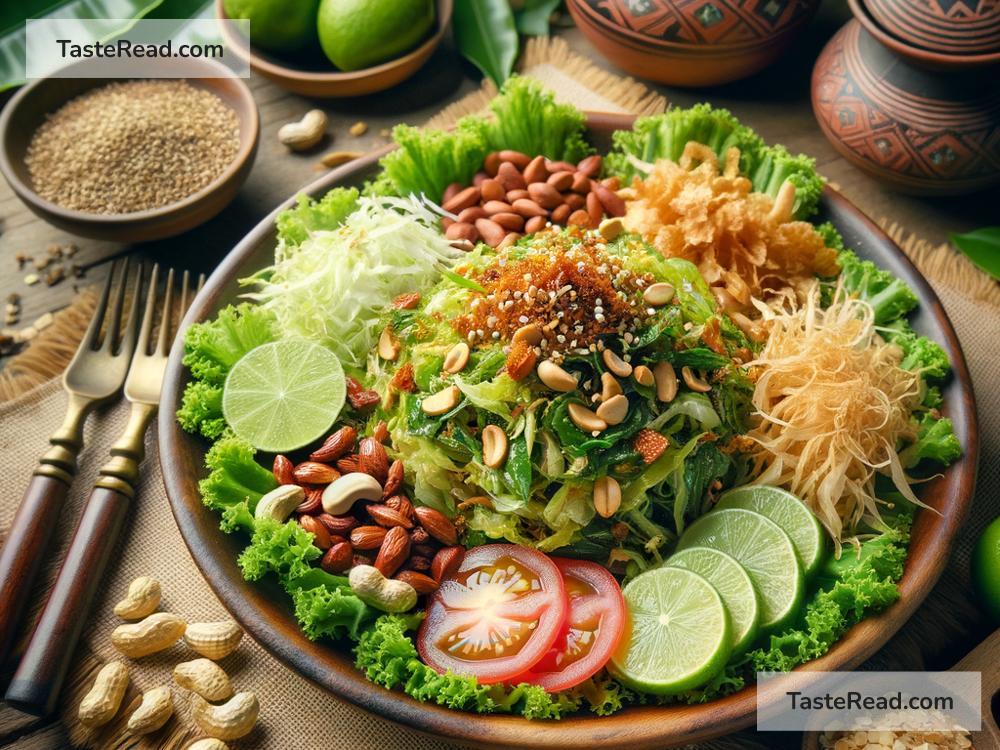Mastering the Secrets of Traditional Burmese Tea Leaf Salad (Lahpet)
If you’re looking to explore vibrant and exciting flavors, traditional Burmese tea leaf salad, known as Lahpet, is the dish for you. This iconic food is not only delicious but also rich in history and tradition. It’s a unique blend of textures, tastes, and cultural significance that will transport your taste buds to Myanmar (formerly Burma). Ready to dive into the secrets of making Lahpet in your own kitchen? Let’s start!
What Makes Lahpet Special?
Lahpet is more than just a salad in Myanmar; it’s a symbol of hospitality and unity. Tea is a big part of Burmese culture, and fermented tea leaves are the star ingredient in this dish. The name “Lahpet” literally means “tea” in Burmese. Traditionally, Lahpet is served at celebrations and important gatherings, showcasing the warm and welcoming nature of Burmese people.
What sets Lahpet apart is its unique combination of flavors and textures: the slight bitterness of fermented tea leaves, the crunch of nuts and seeds, the savoriness of garlic, and the tangy freshness of lime or tomatoes. It’s a wonderful mix of salty, sour, bitter, and nutty elements that make every bite exciting.
The Key Ingredients
To make an authentic Lahpet, you’ll need a few key ingredients. Some of them might not be common in your local supermarket, but fear not—with a little creativity, you can recreate this dish at home.
1. Fermented Tea Leaves
These are the most important part of the dish. In Myanmar, you may find premade packs of seasoned, fermented tea leaves called “lahpet thoke.” Outside of Myanmar, it can be tricky to find, but some specialty Asian stores or online retailers might carry it. Alternatively, you can experiment with fermenting your own tea leaves—which is surprisingly fun and easy to try.
2. Crunchy Mix-Ins
The crunchy mix-ins give Lahpet its irresistible texture. Typical choices include:
– Fried garlic
– Peanuts
– Fried yellow peas
– Sesame seeds
– Roasted chickpeas
– Sunflower seeds
You can mix and match based on what you have available. The idea is to create a variety of bite-sized, crunchy toppings.
3. Fresh Aromatics and Vegetables
Fresh salad items balance the richness of the fermented tea leaves. It often includes:
– Shredded cabbage
– Chopped tomatoes
– Sliced chili peppers
– Lime wedges
Some recipes also add a touch of finely chopped cilantro or green onions for extra flavor.
4. Seasonings
Lahpet is seasoned with fish sauce, lime juice, a drizzle of oil, and a pinch of salt to create a perfect harmony of salty and tangy notes.
Step-by-Step Guide to Making Lahpet
Here’s how you can create this flavorful salad right in your kitchen.
Step 1: Prepare the Fermented Tea Leaves
If you have pre-made fermented tea leaves, you’re good to go! If not, here’s a simple DIY method:
1. Brew strong green tea using loose tea leaves (skip tea bags if possible—they often contain fillers).
2. Let the leaves cool completely and drain off any excess water.
3. Mix the tea leaves with a touch of sesame oil, fish sauce, minced garlic, and salt. Store this in an airtight container to ferment overnight or longer, depending on how strong a flavor you want.
Step 2: Fry Your Crunchy Mix-Ins
Heat a small amount of oil in a frying pan and fry garlic slices until golden and crispy. Set them aside. For an authentic touch, lightly fry yellow peas (or use roasted chickpeas as a replacement). Roast or fry peanuts and sesame seeds until they’re slightly fragrant. Make sure everything cools before mixing.
Step 3: Prepare Fresh Ingredients
Thinly slice cabbage, cube tomatoes, and chop green chilies. Arrange all the vegetables separately for easy assembling later.
Step 4: Assemble the Salad
Here comes the fun part! Take a large plate or bowl and arrange each ingredient in sections rather than mixing everything right away. Place the fermented tea leaves in the center and surround them with crunchy toppings on one side and fresh vegetables on the other. This is how Lahpet is traditionally served—beautiful presentation is key!
Step 5: Add Seasoning
Just before serving, squeeze fresh lime juice over the dish, drizzle fish sauce or soy sauce, and toss it all together so every bite has a mix of textures and flavors.
How to Eat Lahpet
You can serve Lahpet as a side dish, appetizer, or light snack. In Myanmar, it’s often enjoyed as a communal dish, where everyone gathers around and shares from a single plate. Don’t forget to mix everything well before digging in—ensuring a perfect balance of flavors in every bite.
Final Tips for Mastering Lahpet
- Don’t Be Afraid to Experiment: If it’s hard to find certain ingredients, substitute them with similar options. For example, spinach can be used in place of fermented tea leaves for a slightly different, fresh salad.
- Adjust to Your Taste: Some people like it extra crunchy, while others prefer a stronger tea flavor. Feel free to tweak the ratios of toppings and tea leaves.
- Presentation Matters: A big part of Lahpet’s charm is the eye-catching way ingredients are laid out. Take your time to make it look beautiful before serving.
Conclusion
Making Burmese tea leaf salad is an exciting culinary adventure. Lahpet is not only a feast for your taste buds but also a way to connect with Myanmar’s traditions and hospitality. Whether you’re serving it at a dinner party or enjoying it on your own, Lahpet is sure to add a burst of flavor and culture to your table. So grab your tea leaves, get creative with your toppings, and start mastering the secrets of this iconic dish. Happy cooking!


